Barking Hospital
Upney Lane, Barking, Essex IG11 9LX
Medical dates:
Medical character:
Infectious diseases. Later, acute and maternity, then geriatric. Now becoming a community hospital.
In the early 1890s Barking Urban District Council built an infectious
diseases hospital on Upney Lane, to the west of Rookery Hall.
The Upney Isolation Hospital opened in 1893, dealing with those suffering from scarlet fever, diphtheria and other infectious diseases (but not smallpox). In July and August 1896 some 13 patients were admitted to the Hospital following an outbreak of typhoid fever which affected 23 people in the region.
In the early part of the 20th century the Council acquired more land nearby and the Hospital was extended, with the addition of a new ward block at the southwest part of the site.
By the mid 1930s Barking Corporation had acquired the rest of the land bordering Upney Lane to Upney station, and a new isolation hospital was built on Upney Meadow to the south of the original building, parallel to the railway line.
In 1936, a maternity pavilion was built on the site of the original isolation hospital in response to the need for more maternity beds (the nearby Becontree Estate had a birthrate which was double the national average).
The Hospital now comprised two parts on the 18 acre site - at the southern part was the Upney (Isolation) Hospital with 108 beds and, at the northern, the Upney (Maternity) Hospital with 22 beds. In 1938 an ENT Department was established, dealing mainly with the removal of tonsils and adenoids.
During WW2 the Upney (Maternity) Hospital became a principal casualty hospital for the Emergency Medical Service. It had 24 beds.
Both Hospitals joined the NHS in 1948 as a maternity hospital under the name of Barking Hospital, under the control of the Ilford and Barking Group Hospital Management Committee, part of the North East Metropolitan Regional Hospital Board. The Hospital had 108 beds, which had been reduced to 74 by 1951.
By 1954 the Hospital had 76 beds - 54 for maternity patients and 22 for chronically sick elderly females - in the former isolation section at the south, whilst the northern building became the Out-Patients Department, also housing the Borough Chest Clinic and Physiotherapy Department.
At the end of the 1950s, because of the shortage of beds, the Hospital Management Committee decided it should become a general hospital for the group. The site was to be redeveloped, as the scattered bungalow buildings used for fever patients were no longer suitable as ward accommodation. The work was to commence in 1963 and be completed by 1967.
In the meantime upgrading works were carried out on the existing facilities. In January 1958 the lighting on the labour ward was improved with the installation of mobile operating lamps. The operating theatre was modernised and re-equipped for £5,000. The 4-bedded wards in both maternity units were cubicled and curtained. Glass partitioning for weather protection was erected on the verandah of Sydenham Ward (the antenatal and gynaecological ward), which had the only verandah that had remained open to all the elements. All the woollen blankets on the wards were replaced by cellular cotton blankets (which were boilable).
In 1958 work began to convert Ross Ward into an up-to-date surgical ward with 16 beds, at a cost of £9,000. Jenner Ward, the medical ward, was to be modernised and become a geriatric ward.
The mortuary remained a problem. Post-mortems were carried out in the same room where corpses rested; relatives were only allowed to see the deceased through a window, as the body lay on a slab beside the post-mortem table.
In May 1959 the renewed Ross Ward opened - the Hospital's first modern ward - for surgical and gynaecological patients. The Hospital then had 98 beds, used variously for maternity, surgical, gynaecological and chronic cases. In addition, there were 4 cots for premature babies.
Although some 90% of nurses were non-resident, it was recognised that there was a need for a Recreation Hall; the Hospital's League of Friends raised some £25,000 towards the cost of this project. The Hall was built at the far southeastern part of the site.
The Out-Patients building - the Upney Clinic - now also accommodated an orthopaedic clinic.
By 1960 the Hospital admitted mainly female patients. Plans were prepared for the expansion of the Hospital from its current 102 beds to 250 general beds by the erection of a 4-storey block at a cost of £1m. In the meantime, improvements to the existing wards continued. Stainless steel sinks were provided on all wards and in the main kitchen. The verandah to Jenner Ward, now the female geriatric ward, was made into a pleasant sitting room and fitted with Venetian blinds.
During the 1950s a severe shortage of nursing staff, especially midwives, meant that some beds had had to be closed but, in June 1960, deliveries resumed in Harvey Ward, relieving the pressure on Williams Ward, the main maternity ward. A Special Baby Care Unit for premature babies opened in Williams Ward (babies were also accepted from other hospitals).
The need for a Leg Unit had been recognised, and this opened in April 1961 in Paget Ward. The 15-bedded unit had cost £5,500. Patients were seen in the Out-Patients Department at King George Hospital, Ilford, and operated on at Barking Hospital. A special X-ray service was supplied by Chadwell Heath Hospital.
In 1965 the Hospital had 110 beds for mainly female patients.
The new £1m building, built just to the north of the existing ward buildings, was officially opened by Princess Alexandra in April 1967.
In 1970 the Hospital had 286 beds for mainly acute and maternity cases.
Following a major reorganisation of the NHS in 1974, the Hospital came under the control of the East Roding District Health Authority, part of the North East Thames Regional Health Authority.
The Hospital was rebuilt during the 1980s and, in 1987, a new maternity wing was opened, built on the site of the old Out-Patients building. The Hospital then had 314 beds for mainly acute and maternity patients.
In 1990 the Hospital was under the control of Redbridge District Health Authority and had 362 beds for acute and maternity cases. In 1993 it came under the Redbridge Health Care Trust, when it had 254 beds for acute care and rehabilitation. By 1995 it had 96 beds for acute care and geriatric patients.
In 1999, most of the site was sold off to Wilcon Homes for housing development, and a small part to Hanover Housing for apartments with associated care facilities for elderly people.
In 2000 the Hospital had 96 beds, but only three of its four wards were operational as services began to be run down. In 2003 it came under the control of the Barking, Havering and Redbridge Hospitals NHS Trust; there were notionally 105 beds.
In 2007 medical and surgical in-patient services moved to King George Hospital in Barley Lane, while mental health in-patients were transferred to Grays Court, an intermediate care centre in Dagenham.
Update: June 2011
Work on the £12m extension began in 2009. It has now been completed and opened in March 2011. Facilities include an Out-patient Department, Community Recovery Services (for mental health, apparently) and a pharmacy, but the maternity unit and imaging services have yet to begin operating. The Sydenham Centre (now known as the Sexual Health Centre), a purpose-built 2-storey building, opened in January 2011. NHS Barking and Dagenham hope to open the remaining facilities, including the 4-bed midwife-led birthing unit, by autumn 2011.
Surplus land will be sold off for further house development.
Update: April 2015
The Barking Community Hospital was officially re-opened in July 2013 by Margaret Hodge, M.P.
The Upney Isolation Hospital opened in 1893, dealing with those suffering from scarlet fever, diphtheria and other infectious diseases (but not smallpox). In July and August 1896 some 13 patients were admitted to the Hospital following an outbreak of typhoid fever which affected 23 people in the region.
In the early part of the 20th century the Council acquired more land nearby and the Hospital was extended, with the addition of a new ward block at the southwest part of the site.
By the mid 1930s Barking Corporation had acquired the rest of the land bordering Upney Lane to Upney station, and a new isolation hospital was built on Upney Meadow to the south of the original building, parallel to the railway line.
In 1936, a maternity pavilion was built on the site of the original isolation hospital in response to the need for more maternity beds (the nearby Becontree Estate had a birthrate which was double the national average).
The Hospital now comprised two parts on the 18 acre site - at the southern part was the Upney (Isolation) Hospital with 108 beds and, at the northern, the Upney (Maternity) Hospital with 22 beds. In 1938 an ENT Department was established, dealing mainly with the removal of tonsils and adenoids.
During WW2 the Upney (Maternity) Hospital became a principal casualty hospital for the Emergency Medical Service. It had 24 beds.
Both Hospitals joined the NHS in 1948 as a maternity hospital under the name of Barking Hospital, under the control of the Ilford and Barking Group Hospital Management Committee, part of the North East Metropolitan Regional Hospital Board. The Hospital had 108 beds, which had been reduced to 74 by 1951.
By 1954 the Hospital had 76 beds - 54 for maternity patients and 22 for chronically sick elderly females - in the former isolation section at the south, whilst the northern building became the Out-Patients Department, also housing the Borough Chest Clinic and Physiotherapy Department.
At the end of the 1950s, because of the shortage of beds, the Hospital Management Committee decided it should become a general hospital for the group. The site was to be redeveloped, as the scattered bungalow buildings used for fever patients were no longer suitable as ward accommodation. The work was to commence in 1963 and be completed by 1967.
In the meantime upgrading works were carried out on the existing facilities. In January 1958 the lighting on the labour ward was improved with the installation of mobile operating lamps. The operating theatre was modernised and re-equipped for £5,000. The 4-bedded wards in both maternity units were cubicled and curtained. Glass partitioning for weather protection was erected on the verandah of Sydenham Ward (the antenatal and gynaecological ward), which had the only verandah that had remained open to all the elements. All the woollen blankets on the wards were replaced by cellular cotton blankets (which were boilable).
In 1958 work began to convert Ross Ward into an up-to-date surgical ward with 16 beds, at a cost of £9,000. Jenner Ward, the medical ward, was to be modernised and become a geriatric ward.
The mortuary remained a problem. Post-mortems were carried out in the same room where corpses rested; relatives were only allowed to see the deceased through a window, as the body lay on a slab beside the post-mortem table.
In May 1959 the renewed Ross Ward opened - the Hospital's first modern ward - for surgical and gynaecological patients. The Hospital then had 98 beds, used variously for maternity, surgical, gynaecological and chronic cases. In addition, there were 4 cots for premature babies.
Although some 90% of nurses were non-resident, it was recognised that there was a need for a Recreation Hall; the Hospital's League of Friends raised some £25,000 towards the cost of this project. The Hall was built at the far southeastern part of the site.
The Out-Patients building - the Upney Clinic - now also accommodated an orthopaedic clinic.
By 1960 the Hospital admitted mainly female patients. Plans were prepared for the expansion of the Hospital from its current 102 beds to 250 general beds by the erection of a 4-storey block at a cost of £1m. In the meantime, improvements to the existing wards continued. Stainless steel sinks were provided on all wards and in the main kitchen. The verandah to Jenner Ward, now the female geriatric ward, was made into a pleasant sitting room and fitted with Venetian blinds.
During the 1950s a severe shortage of nursing staff, especially midwives, meant that some beds had had to be closed but, in June 1960, deliveries resumed in Harvey Ward, relieving the pressure on Williams Ward, the main maternity ward. A Special Baby Care Unit for premature babies opened in Williams Ward (babies were also accepted from other hospitals).
The need for a Leg Unit had been recognised, and this opened in April 1961 in Paget Ward. The 15-bedded unit had cost £5,500. Patients were seen in the Out-Patients Department at King George Hospital, Ilford, and operated on at Barking Hospital. A special X-ray service was supplied by Chadwell Heath Hospital.
In 1965 the Hospital had 110 beds for mainly female patients.
The new £1m building, built just to the north of the existing ward buildings, was officially opened by Princess Alexandra in April 1967.
In 1970 the Hospital had 286 beds for mainly acute and maternity cases.
Following a major reorganisation of the NHS in 1974, the Hospital came under the control of the East Roding District Health Authority, part of the North East Thames Regional Health Authority.
The Hospital was rebuilt during the 1980s and, in 1987, a new maternity wing was opened, built on the site of the old Out-Patients building. The Hospital then had 314 beds for mainly acute and maternity patients.
In 1990 the Hospital was under the control of Redbridge District Health Authority and had 362 beds for acute and maternity cases. In 1993 it came under the Redbridge Health Care Trust, when it had 254 beds for acute care and rehabilitation. By 1995 it had 96 beds for acute care and geriatric patients.
In 1999, most of the site was sold off to Wilcon Homes for housing development, and a small part to Hanover Housing for apartments with associated care facilities for elderly people.
In 2000 the Hospital had 96 beds, but only three of its four wards were operational as services began to be run down. In 2003 it came under the control of the Barking, Havering and Redbridge Hospitals NHS Trust; there were notionally 105 beds.
In 2007 medical and surgical in-patient services moved to King George Hospital in Barley Lane, while mental health in-patients were transferred to Grays Court, an intermediate care centre in Dagenham.
Present status (April 2008)
The Hospital site is now divided in two by a small housing estate. The Barking, Havering and Redbridge University Hospitals NHS Trust owns 1.71 hectares of the 2.74 hectare site (as well as the 0.44 hectares of the Upney Lane Centre), while the North East London NHS Foundation Trust owns the remainder. Many of the single-storey buildings have been demolished or will be in the future.
It is planned to extend the existing Hospital and amalgamate all services in the one building, which will become the Barking Community Hospital.
Update: June 2011
Work on the £12m extension began in 2009. It has now been completed and opened in March 2011. Facilities include an Out-patient Department, Community Recovery Services (for mental health, apparently) and a pharmacy, but the maternity unit and imaging services have yet to begin operating. The Sydenham Centre (now known as the Sexual Health Centre), a purpose-built 2-storey building, opened in January 2011. NHS Barking and Dagenham hope to open the remaining facilities, including the 4-bed midwife-led birthing unit, by autumn 2011.
Surplus land will be sold off for further house development.
Update: April 2015
The Barking Community Hospital was officially re-opened in July 2013 by Margaret Hodge, M.P.
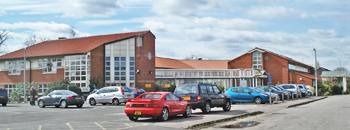
In 2007 the horseshoe-shaped building contained 110 beds in Abbey and Mayesbrook Wards on the left and Ross and Eastbury Wards on the right, with the single-storey former Day Hospital - the Worricker Centre (now used for clinical and non-clinical support services) - in the middle.

The Hedgecock Centre for mental health services is operated by the North East London NHS Foundation Trust.
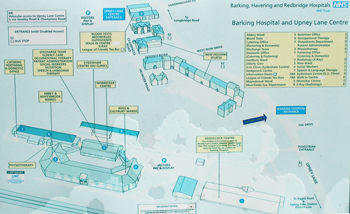
The layout of the Barking Hospital and Upney Lane Centre.

The maternity wing, built in 1987, has become the Upney Lane Centre. It is located some 180 metres away from the main Hospital and contains an Out-Patients Department, a Minor Injuries Unit and an out-reach clinic for Moorfields Eye Hospital.
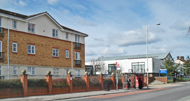

New housing has been built between the Hospital and its Out-Patients Department in the Upney Lane Centre.
Update: June 2011
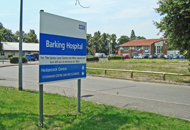
The approach road to Barking Hospital, seen on the right of the image, and the Hedgecock Centre, seen on the left.
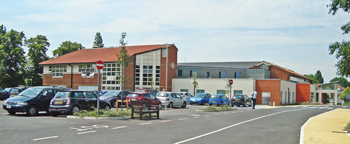
The Hospital building has been extended.
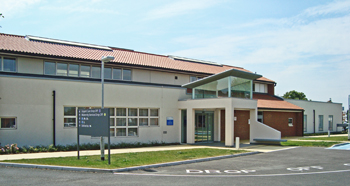
The extension will house the GP surgeries on the right and the Urgent Treatment Centre on the left.
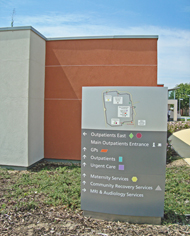
New signage for the new facilitites.
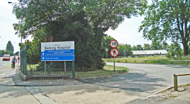

The complicated site requires much signage.
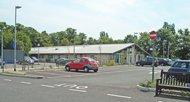
The Hedgecock Centre.
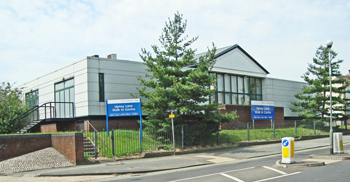
The Upney Lane Centre on Upney Lane (above) and its main entrance at the back of the building (below).
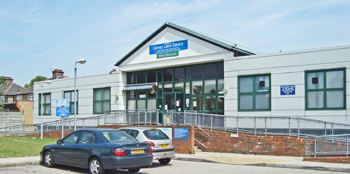


Again, much signage is used to direct patients from Upney Lane to the car park behind the Centre.
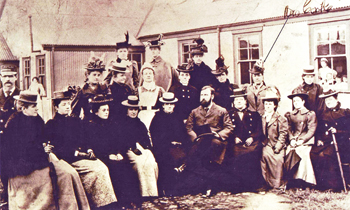
Staff and dignitaries outside one of the ward blocks in 1907. The man in the centre of the image is probably Dr Hugh Herbert Mason, first chairman of Barking Urban District Council.
(Courtesy of Sylvia Kent, author of Barking and Dagenham from Old Photographs).
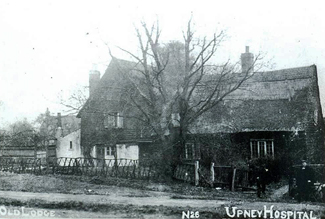
Undated photograph of the old lodge at Upney Hospital.
(Courtesy of Mr Eric Feasey, Archivist for the Friends of Barking Hospital).
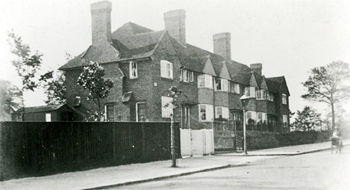
Undated photograph of the Nurses's Home.
(Courtesy of Mr Eric Feasey, Archivist for the Friends of Barking Hospital).
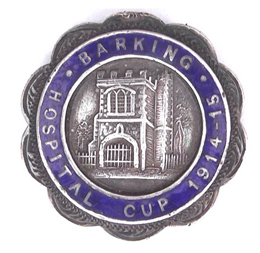
A medallion made for a fob watch commemorating the 1914-15 Barking Hospital cup. It was common for local football teams to support their local hospital.
(Courtesy of Mr Eric Feasey, Archivist for the Friends of Barking Hospital).
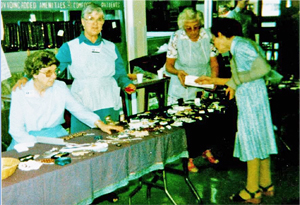
Undated photograph of the Friends of Barking Hospital staff in the tower building.
(Courtesy of Mr Eric Feasey, Archivist for the Friends of Barking Hospital).
(Author unstated) 1896 Typhoid fever at Barking. British Medical Journal 2 (1864), 748.
Brian JG (undated) Hospitals of Barking.
Kent S 2014 Barking and Dagenham from Old Photographs. Stroud, Amberley Publishing.
King J 2019 History buffs visit graveyard in bid to bring Barking's 'greats' back to life. Barking and Dagenham Post.
Tames R 2002 Barking Past. London, Historical Publications.
Williams CL 1937 Report of the Medical Officer of Health. London, Borough of Barking. pp. 26-27, 29-31.
https://api.parliament.uk
https://boroughphotos.org
https://fiftyyearsaborough.wordpress.com
www.british-history.ac.uk
www.hidden-london.com
www.layersoflondon.org
www.theyworkforyou.com
Return to home page